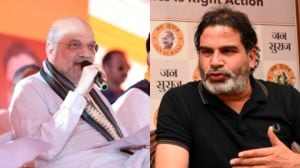Sleeping with the enemy
At the peak of the militaristic euphoria in Rajiv Gandhi's heyday, General K. Sundarji was asked on the eve of his retirement to name Ind...

At the peak of the militaristic euphoria in Rajiv Gandhi’s heyday, General K. Sundarji was asked on the eve of his retirement to name India’s biggest military threat. "The real threat," he said, "is China". And then he added for effect: "Pakistan we can take en passant."
Now you can’t fault George Fernandes for asking how come that statement did not create even a fraction of the outrage that seems to follow each time he merely "reiterates" India’s known positions vis-a-vis China. But the difference is, then it was just a soldier talking and it is fine for soldiers to look at national security purely in terms of border conflicts.
The current problem is more complicated. We have people in their seventies whose minds are still in the sixties and whose worldview has remained frozen. The world, meanwhile, has moved along and it is because they are incapable of fathoming that change that India’s China policy is in such a mess.
Post-Pokharan, the China policy has been hijacked by the Ai mere watanke logo, zara aankh mein bhar lo paani… school of romantics. Most of us who remember the humiliation of 1962 identify with that emotion. But you cannot construct a new national geostrategic doctrine on such nostalgia. It may be useful for building regimental loyalties and josh. Grand strategy requires cool, calculating — and modern — minds.
Vajpayee’s apologists now admit the reference to China in his letter to Clinton was a mistake, but argue that matters would not have become so complicated if George Fernandes had shown more restraint in front of the TV cameras. The fact, however, is probably a bit different. Had it been an isolated outburst from Fernandes it would have been ignored internationally.
But it was taken so seriously only because of the reference in Vajpayee’s letter. Until the letter leaked in Washington and the stuff hit the fan, its authors thought they had pulled off a Kautilyan coup. Here was America, worried about the rise of China, the decline of Russia and harassed byIslamic militancy. It desperately needed an ally, preferably a nuclear-armed one, and here was an application from the new Prime Minister of India with Pokharan-II on the top of the CV. The logic was quite simple. The Americans need an ally to fight their "potential enemy No. 1" and India was now ready.
This message wasn’t lost on either the Chinese or the Americans. Beijing reacted so sharply not because Fernandes was raking up the border issue again but because it saw the explicit effort to muddy the waters before the Clinton visit, which they considered the most vital foreign policy happening in their history since the Nixon-Kissinger overture. India need not have bothered about even this sense of hurt in Beijing if its basic policy postulate, relating to American Sinophobia, had been correct.
But how could it be when our foreign policy is run by people long on memory and short on reading? Even if they had been reading The Economist regularly, they would not have made such simplisticblunders.
Barring the extreme right wing, the entire American media and analyst community has for the past several years been pushing for greater engagement with China while acknowledging its rise as the new superpower and thereby as their potential No. 1 threat in the future. As far back as 1995 Clinton had acknowledged this while welcoming Jiang Zemin: "We welcome China to the great-powers table. But great powers also have great responsibilities."
Washington’s policy has been to engage China economically, politically and even strategically, while keeping the wherewithal ready for a threat that might emerge in three decades when, as per the ADB estimates, China attains a per capita income of $10,000 and the overall size of its economy is thrice as big as America’s.
Until then, the American policy is to strictly avoid doing or saying anything that seems to identify China as a likely enemy. In a special essay in The Economist on the eve of Clinton’s China visit, former US Assistant Secretary ofDefence for International Security and now Dean of the Kennedy School of Government at Harvard University, Joseph Nye Jr., argued: "If the US treats China as an enemy now, it will guarantee an enemy in future. If China becomes aggressive in the future, this policy (of engagement) is reversible… To discard the chances of a more benign future through a misguided belief in the inevitability of conflict would be a tragic mistake."
It was in the face of such pragmatism that India’s post-Pokharan-II "Come US, let’s fight the Chinese together" policy flew so disastrously.
Surely, it is nobody’s case that the Ameri-cans get everything right on their foreign policy. But they couldn’t even have got everything wrong to become the world’s only superpower. The Americans have their concerns about China. But their more immediate worry is about the instability in Russia which may give rise to what is called the "loose nukes" problem, whereby a weakening regime in Moscow may be incapable of preventing the leakage ofnuclear technologies and materials to hostile (mainly Islamic) powers or even terrorist groups. They also need to seal the process of "fixing" the Islamic world with the containment of Iraq and now the likely growth of the Khatami phenomenon in Iran. In all this, in any foreseeable future, China is an ally and not an enemy. So why should we be so outraged if Washington leaked Vajpayee’s letter with such alacrity?
It is a great pity that the authors of this asinine India-US axis against China are still calling the shots and perhaps will never be called to account. But that should not prevent the rest of the establishment, including the Prime Minister, from making a fresh appraisal. A blunder has been made but that is no reason why we must jump to the other extreme. China is, and will be, India’s potential rival No.1, while it may not be true the other way around.
Therefore it is necessary to study and understand what is going on in China, to analyse the profound changes in its society, economy and politicsso that when — and if — it chooses to become a threat or an enemy instead of just a rival, we are prepared.
There are also lessons to learn from the incredible process of China’s modernisation. Analyst and Princeton Professor Minxin Pei (author of From Reform to Revolution: The Demise of Communism in China and the Soviet Union) underlined in a recent essay in Foreign Affairs the Chinese process of democratisation and the problems it’s bringing in its wake.
The economic boom, military modernisation and social transformation in China are also accompanied by other significant changes. In the last 15 years, Minxin Pei estimates, the proportion of college graduates in the Chinese Communist Party’s Central Committee has risen from 55 to 92 percent.
Similarly, the percentage has gone up for the provincial committees from 20 to 79 percent. In all areas of governance, average ages have fallen because of Deng’s strict retirement policy.
This, while we have been muddling along with social justice andgeriatry. The truth is, the more you read about the new China, the more you are convinced that it will be India’s No. 1 rival in decades to come. That is why it is such a tragedy that the whole issue has been trivialised by a few buccaneers in our foreign policy establishment.



- 01
- 02
- 03
- 04
- 05




























